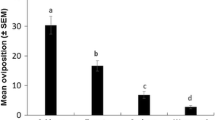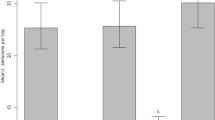Abstract
Field plots of three accessions ofNicotiana glutinosa L. (Nicotiana species accessions 24, 24A, and 24B) at Oxford, North Carolina and Tifton, Georgia were heavily damaged by natural populations of tobacco budworms,Heliothis virescens (F.), during 1985–1989. Experiments in outdoor screen cages demonstrated that all accessions ofN. glutinosa were as prone to oviposition byH. virescens moths as was NC 2326, a commercial cultivar of flue-cured tobacco,N. tabacum L. However, in greenhouse experiments, tobacco budworm larvae did not survive or grow as well when placed on plants ofN. glutinosa as they did when placed on plants of NC 2326. Four labdane diterpenes (manool, 2-hydroxymanool, a mixture of sclareols, and labda-13-ene-8α,15-diol [labdenediol]) and two sucrose ester fractions (2,3,4-tri-O-acyl-3′-O-acetyl-sucrose [G-SE-I] and 2,3,4,-tri-O-acyl-sucrose [G-SE-II]) were isolated from green leaves of the three accessions ofN. glutinosa. These components were bioassayed for their effects on the ovipositional behavior of tobacco budworm moths using small screen cages in a greenhouse at Oxford, North Carolina. Labdenediol, manool, and both sucrose ester fractions stimulated tobacco budworm moths to oviposit on a tobacco budworm-resistant Tobacco Introduction, TI 1112 (PI 124166), when these materials were sprayed onto a leaf.
Similar content being viewed by others
References
Arrendale, R.F. andMartin, R.M. 1988. The preparation of immobilized stationary phase fused silica capillary columns with OV-1701-vinyl deactivation.J. High Resolut. Chromalogr. Chromatogr. Commun. 11:157–161.
Arrendale, R.F., Severson, R.F., Sisson, V.A., Costello, C.E., Leary, J.A., Himmelsbach, D.S., andvan Halbeek, H. 1990. Characterization of the sucrose ester fraction fromNicotiana glutinosa.J. Agric. Food Chem. 38:75–85.
Bailey, J.A., Vincent, G.G., andBurden, R.S. 1974. Diterpenes fromNicotiana glutinosa and their effects on fungal growth.J. Gen. Microbiol. 85:57–64.
Bailey, J.A., Carter, G.A., Burden, R.S., andWain, R.S. 1975. Control of rust diseases by diterpenes fromNicotiana glutinosa.Nature 255:328–329.
Baumhover, A.H. 1985.Manduca sexta, pp. 387–400,in P. Singh and R.F. Moore (eds.). Handbook of Insect Rearing, Vol. 2. Elsevier, Amsterdam.
Burk, L.G., andStewart, P.A. 1969. Resistance ofNicotiana species to the green peach aphid.J. Econ. Entomol. 62:1115–1117.
Burk, L.G., andStewart, P.A. 1971. Survey of resistance amongNicotiana species to tobacco hornworm and budworm larvae.Tobacco Sci. 15:32–34.
Cohen, Y., Eyal, H., Goldschmidt, Z., andSklarz, B. 1983. A preformed chemical inhibitor of tobacco powdery mildew on leaves ofNicotiana glutinosa.Physiol. Plant Pathol. 22:143–150.
Colledge, A., Reid, W.W., andRussell, R.A. 1974. A survey of surface diterpenoids of green leaves.Ann. du Tabak, Sec. 2, 11:159–164.
Cutler, H.G., Reid, W.W., andDeletang, J. 1977. Plant growth inhibiting properties of diterpenes from tobacco.Plant Cell Physiol. 18:711–714.
Cutler, H.G.,Severson, R.F.,Cole, P.D.,Jackson, D.M., andJohnson, A.W. 1986. Secondary metabolites from higher plants: Their possible role as biological control agents, pp. 178–196,in M.B. Green and P.A. Hedin (eds.), Natural Resistance of Plants to Pests: Roles of Allelochemicals. Am. Chem. Soc. Symp. Ser. No. 296.
Gerstel, D.U. 1945. Inheritance inNicotiana tabacum. XX: The addition ofN. glutinosa chromosomes to tobacco.J. tiered. 36:197–206.
Goodspeed, T.H. 1954. The genusNicotiana. Chronica Botanica, Waltham, Massachusetts.
Granzow, P., Shalosky, T., andJohnson, A. 1985. Effect of nicotine concentration in an artificial diet on the development and survival of newly hatched tobacco budworm larvae.Tobacco Sci. 29:111–112.
Greene, G.L., andThurston, R. 1971. Ovipositional preference ofHeliothis virescens forNicotiana species.J. Econ. Entomol. 64:641–643.
Gunasena, G.H., Vinson, S.B., andWilliams, H.J. 1990. Effect of nicotine on growth, development, and survival of the tobacco budworm (Lepidoptera: Noctuidae) and the parasitoidCampoletis sonorensis (Hymenoptera: Ichneumonidae).J. Econ. Entomol. 83:1777–1782.
Jackson, D.M., andSeverson, R.F. 1989. Evaluating tobacco for resistance to insect pests, pp. 101–124,in T. Stalker and C. Chapman (eds.), IBPGR Training Courses: Lecture Series 2. Scientific Management of Germplasm: Characterization, Evaluation and Enhancement. Internat. Board Plant Genetics Resources, Rome. 194 pp.
Jackson, D.M., Cheatham, J.S., Pitts, J.M., andBaumhover, A.H. 1983. Ovipositional response of tobacco budworm moths (Lepidoptera: Noctuidae) to Tobacco Introduction 1112 and NC 2326 in cage tests.J. Econ. Entomol. 76:1303–1308.
Jackson, D.M., Severson, R.F., Johnson, A.W., Chaplin, J.F., andStephenson, M.G. 1984. Ovipositional response of tobacco budworm moths (Lepidoptera: Noctuidae) to cuticular chemical isolates from green tobacco leaves.Environ. Entomol. 13:1023–1030.
Jackson, D.M., Severson, R.F., Johnson, A.W., andHerzog, G.A. 1986. Effects of cuticular duvane diterpenes from green tobacco leaves on tobacco budworm (Lepidoptera: Noctuidae) oviposition.J. Chem. Ecol. 12:1349–1359.
Jackson, D.M.,Severson, R.F.,Johnson, A.W.,Gwynn, G.R.,Chaplin, J.F.,Sisson, V.A., andHerzog, G.A. 1988. Host plant resistance in tobacco toHeliothis species, pp. 31–49,in G.A. Herzog, S. Ramaswamy, G. Lentz, J.L. Goodenough, and J.J. Hamm (eds.), Theory and Tactics ofHeliothis Population Management: III. Emerging Control Tactics and Techniques. South. Coop. Ser. Bull. No. 337.
Jackson, D.M., Severson, R.F., andJohnson, A.W. 1989. Effects of natural tobacco constituents on insect survival, development, and behavior.Recent Adv. Tobacco Sci. 15:26–116.
Jurzysta, A. 1983. Flavanoids from leaves from someNicotiana species.Pamiet. Pulawski 79:231–237.
Lukefahr, M.J., andMartin, D.F. 1966. Cotton-plant pigments as a source of resistance to the bollworm and the tobacco budworm.J. Econ. Entomol. 59:176–179.
Parr, J.C. 1967. Resistance inNicotiana and Some Other Plants of the Family, Solanaceae, to the Tobacco Hornworm,Manduca sexta (Johan.): Larval Survival and Oviposition Responses. Master's thesis, University of Kentucky. 69 pp.
Parr, J.C., andThurston, R. 1968. Toxicity ofNicotiana andPetunia species to larvae of the tobacco hornworm.J. Econ. Entomol. 61:1525–1531.
Reid, W.W. 1974. The cuticular and cytoplasmic lipids ofNicotiana tabacum. Ann. du Tabak, SEITA 11:151–159.
Reid, W.W. 1979. The diterpenes ofNicotiana species andN. tabacum cultivars, pp. 273–278,in J.G. Hawkes, R.N. Lester, and A.D. Skelding (eds.), The Biology and Taxonomy of the Solanaceae. Linnean Soc. Symp. Ser. No. 7, Academic Press, New York.
SAS Institute. 1985. SAS User's Guide: Statistics, Version 5 Ed. SAS Institute, Gary, North Carolina.
Severson, R.F., Arrendale, R.F., Chortyk, O.T., Johnson, A.W., Jackson, D.M., Gwynn, G.R., Chaplin, J.F., andStephenson, M.G. 1984. Quantitation of cuticular components of green tobacco leaf.J. Agric. Food Chem. 32:566–570.
Severson, R.F., Arrendale, R.F., Chortyk, O.T., Green, C.R., Thome, F.A., Stewart, J.L., andJohnson, A.W. 1985a. Isolation and characterization of the sucrose esters of the cuticular waxes of green tobacco leaf.J. Agric. Food Chem. 33:870–875.
Severson, R.F., Johnson, A.W., andJackson, D.M. 1985b. Cuticular constituents of tobacco: Factors affecting their production and their role in insect and disease resistance and smoke quality.Recent Adv. Tobacco Sci. 11:105–174.
Severson, R.F., Mueller, S.J., Sisson, V.A., Jackson, D.M., andStephenson, M.G. 1988a. Isolation of the major cuticular diterpenes fromNicotiana glutinosa. 42nd Tobacco Chem. Res. Conf., 42:29.
Severson, R.F., Stephenson, M.G., Johnson, A.W., Jackson, D.M., andChortyk, O.T. 1988b. Isolation and preparative chromatography of the major cuticular diterpenes of green tobacco.Tobacco Sci. 32:99–103.
Severson, R.F., Jackson, D.M., Johnson, A.W., Sisson, V.A., andStephenson, M.G. 1990. Ovipositional behavior of tobacco budworm and tobacco hornworm: Effects of cuticular components fromNicotiana species, pp. 264–277,in P.A. Hedin (ed.), Naturally Occurring Pest Bioregulators. Am. Chem. Soc. Symp. Ser. No. 449, Am. Chem. Soc, Washington, D.C.
Shaver, T.N., andLukefahr, M.J. 1969. Effect of flavanoid pigments and gossypol on growth and development of the bollworm, tobacco budworm, and pink hollworm.J. Econ. Entomol. 62:643–646.
Sisson, V.A., andSeverson, R.F. 1990. Alkaloid composition of theNicotiana species.Beitrage Tabakforsch. Internat. 14:327–339.
Snook, M.E., Mason, P.F., andSisson, V.A. 1986. Polyphenols in theNicotiana species.Tobacco Sci. 30:43–49.
Stavely J.R. 1979. Disease resistance, pp. 87–110,in R.D. Durbin (ed.),Nicotiana: Procedures for Experimental Use. U.S. Dept. Agric. Tech. Bull. No. 1586.
Steel R.G.D., andTorrie J.H. 1960. Principles and procedures of statistics with special reference to the biological sciences. McGraw-Hill Book Co. 481 pp.
Tatemichi, Y. 1990. Illustrated Book of the GenusNicotiana. Japan Tobacco Inc., Plant Breed. Genet. Res. Lab., Shizuokaken, Japan. 234 pp.
Thurston, R. 1961. Resistance inNicotiana to the green peach aphid and some other tobacco insect pests.J. Econ. Entomol. 54:946–949.
Thurston, R.,Parr, J.C., andSmith, W.T. 1966. The phylogeny ofNicotiana and resistance to insects, pp. 424–430,in Proc. 4th Internat. Tobacco Sci. Congr., Athens, Greece.
Author information
Authors and Affiliations
Additional information
This article reports the results of research only. Mention of a proprietary product does not constitute endorsement or recommendation for its use by USDA, ARS, or by the North Carolina Agricultural Research Service.
Rights and permissions
About this article
Cite this article
Jackson, D.M., Severson, R.F., Sisson, V.A. et al. Ovipositional response of tobacco budworm moths (Lepidoptera: Noctuidae) to cuticular labdanes and sucrose esters from the green leaves ofNicotiana glutinosa L. (Solanaceae). J Chem Ecol 17, 2489–2506 (1991). https://doi.org/10.1007/BF00994597
Received:
Accepted:
Issue Date:
DOI: https://doi.org/10.1007/BF00994597




